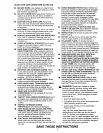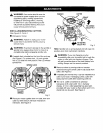
TOOFAST
TOOSLOW Fig. 10
Your router is an extremely high-speed tool (25,000
RPM no-load speed), and will make clean, smooth cuts
if allowed to run freely without the overload of a forced
(too fast) feed. Three things that cause "force feeding"
are bit size, depth-of-cut, and workpiece characteristics.
The larger the bit or the deeper the cut, the more slowly
the router should be moved forward. If the wood is very
hard, knotty, gummy or damp, the operation must be
slowed still more.
You can always detect "force feeding" by the sound of
the motor. Its high-pitched whine will sound lower and
stronger as it loses speed. Also, the strain of holding
the tool will be noticeably increased.
TOO SLOW FEEDING
It is also possible to spoil a cut by moving the router
forward too slowly. When it is advanced into the work
too slowly, a revolving bit does not dig into new wood
fast enough to take a bite; instead, it simply scrapes
away sawdust-like particles. Scraping produces heat,
which can glaze, burn, or mar the cut -- in extreme
cases, can even overheat the bit so as to destroy its
hardness.
tn addition, it is more difficult to control a router when
the bit is scraping instead of cutting. With practically
no load on the motor the bit will be revolving at close
to top RPM, and will have a much greater than normal
tendency to bounce off the sides of the cut (especially
if the wood has a pronounced grain with hard and soft
areas). As a result, the cut produced may have
rippled, instead of straight sides. See Figure 10.
"Too-slow feeding" can also cause your router to take
off in a wrong direction from the intended line of cut.
Always grasp and hold your router firmly with
both hands when routing.
You can detect "too-slow feeding" by the runaway
too-highly pitched sound of the motor; or by feeling
the "wiggle" of the bit in the cut.
DEPTH OF CUT
As previously mentioned, the depth of cut is important
because it affects the rate of feed which, in turn,
affects the quality of a cut (and, also, the possibility of
damage to your router motor and bit). A deep cut
requires a slower feed than a shallow one, and a too
deep cut will cause you to slow the feed so much that
the bit is no longer cutting, it is scraping, instead.
Making a deep cut is never advisable. The smaller
bits---especially those only 1/16 inch in diameter-
are easily broken off when subjected to too much side
thrust. A large enough bit may not be broken off, but if
the cut is too deep a rough cut will result -- and it may
be very difficult to guide and control the bit as desired.
For these reasons, we recommend that you do not
exceed 1/8 inch depth of cut in a single pass,
regardless of the bit size or the softness or condition
of the workpiece. See Figure 11.
DEPTH WIDTH
OFCUT CUT
Fig. 11
11


















